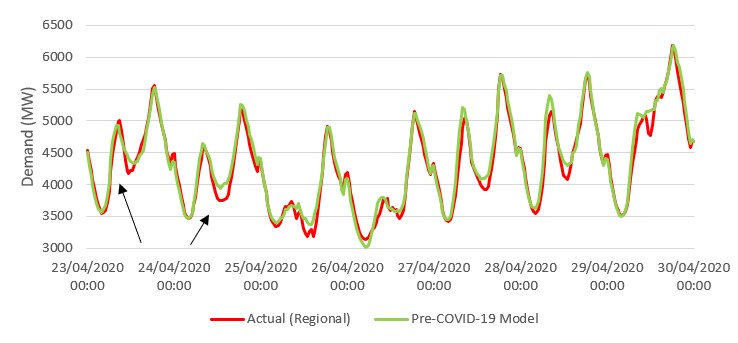As we noted
last week, Australia, overall, has seen only moderate reductions in demand
over the past few weeks due to COVID-19. Much greater reductions have been observed
in parts of Europe and the United States where tighter pandemic restrictions
and full lockdowns had been implemented. Demand reductions of up to 30% were
observed in those countries during those periods.
AEMO’s dedicated Operational Forecasting team (who have been working with
global forecasting experts, and other grid operators in Europe and the US, to
develop state of the art models to help us isolate COVID-19 impacts from the
normal variation in demand patterns) advised that they expected that reductions
in demand may continue to increase incrementally over time at current levels of
restrictions, with some states likely to exhibit changes in demand.
Some potential COVID-19 demand impacts have now been recognised in Victoria
where average demand reduction during morning peaks reached 8% (approx. 400 MW)
for the first time over a working week in the state. The midday trough fell 5%
(approx. 200 MW) from pre-COVID-19 levels on weekdays and 3% on weekends
(approx. 100 MW) and rooftop solar variability makes it uncertain if the demand
reductions are from COVID-19.
VIC actual
operational demand against pre-COVID-19 control model. Reductions on the
morning peak beginning to be observed, with the magnitude and timing of the
morning peak shifting later in the day. Potential reduction in the midday
trough are also observed.
Elsewhere across Australia COVID-19 demand reductions continue to be observed in Queensland and New South Wales which has seen further falls in demand over the weekday morning and night-time while reductions continue to be lower on weekends. Some insights include:
· Reductions of 8% to 10% (approx. 600MW to 700MW) are observed in the morning, and 6% to 7% (approx. 500MW to 600MW) are observed in the afternoon on weekdays. The evening peak remains less impacted, with average reductions of 3% to 4% (approx. 300MW to 400MW) being observed on weekdays
· Reductions in demand in NSW continues to be lower on weekends than on weekdays. Consistent reductions of 4% to 6% (up to 400MW) are observed across most of the day except for the evening peak which appears to be marginally impacted by 1% to 2%
· Queensland has seen a small increase in demand compared to the last 2 weeks, however, demand is still lower than what it was in early April. The greatest reductions, of between 8% and 9% (approx. 450MW to 550MW) are observed on weekday mornings. Queensland reductions are similar to NSW in that they demonstrate a lower impact on weekends than weekdays
· South Australia has demonstrated some demand reductions, however, the natural variability in demands means that no conclusive attribution to COVID-19 can be made
· Tasmania continues not to demonstrate any demand reductions outside of natural variability
Change in the across-the-day demand profile in all regions has been observed, with morning peaks observed later than usual for this time of year, nominally due to people working from home and getting up later.
As Australia’s restrictions are lifted state by state demand is expected to increase, as has been demonstrated in overseas cases, including, most prominently, Italy.
In addition, we expect that as cooler weather prevails, we might see an increase in load volatility, reflective of a greater proportion of residential (weather sensitive) load on the grid. All regions except Queensland are expected to see a lift in maximum and minimum demands during the cold weather.
We will continue to keep you updated on all the latest pandemic related impacts and activity domestically and internationally so stayed tuned for more on this evolving situation.
For all the latest news, insights and analysis from the Australian energy industry
subscribe to our fortnightly newsletter and download the Energy Live app
on Apple or Android.







